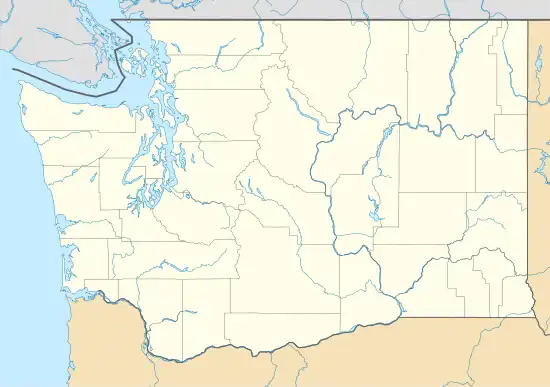Keller, Washington | |
|---|---|
 Keller  Keller | |
| Coordinates: 48°04′44″N 118°41′06″W / 48.07889°N 118.68500°W | |
| Country | United States |
| State | Washington |
| County | Ferry |
| Area | |
| • Total | 9.5 sq mi (24.6 km2) |
| • Land | 9.5 sq mi (24.6 km2) |
| • Water | 0.0 sq mi (0.0 km2) |
| Elevation | 1,499 ft (457 m) |
| Population (2010) | |
| • Total | 234 |
| • Density | 25/sq mi (9.5/km2) |
| Time zone | UTC-8 (Pacific (PST)) |
| • Summer (DST) | UTC-7 (PDT) |
| ZIP code | 99140 |
| Area code | 509 |
| GNIS feature ID | 1518417[1] |
| FIPS code | 53-34960 |
Keller is an unincorporated community and census-designated place (CDP) in southwestern Ferry County in the northeastern part of the U.S. state of Washington. As of the 2010 census, the population was 234.[2]
History
The town is located in the valley of the Sanpoil River, and was founded in 1898[3] by Baby Ray Peone, a local fisherman. The town was located in the area known as "God's Country" (or "Old Keller" to the locals). At its height the town had an estimated population of 3,500 and even featured a minor league baseball team and red light district. The town was moved several times beginning in 1940 due to backwatering from the Grand Coulee Dam which flooded its previous locations,[3] and is now located 18 miles (29 km) north of the Columbia River. The series of moves seriously reduced its population over time.
The town is encompassed by the Colville Indian Reservation, which has an estimated population of roughly 1,200 people mostly of Native American descent and primarily members of the Sanpoil tribe, one of the Twelve Tribes that make up the Colville Confederated Tribes and one of the few Indian Nations that was never relocated by order of the U.S. government.
Mount Tolman mining proposal
From 2004 to 2006 the town of Keller was the center of attention after the Colville Tribes' controversial decision to explore the possibility of opening up an open-pit molybdenum mine on Mount Tolman in the San Poil Valley. Locals and grassroots environmental groups rallied around the opposition to the mine because the mining project would be too much of a hazard to the population of Washington state, given research that the mine contained hazardous materials such as uranium and toxic dust that, if exposed to a windy location, could spread up to 200 miles (320 km), encompassing most of Washington's economic farming country. The proposal to mine also included the use of acid leaching to retrieve the metals being mined, and given the mountain's short distance to the Columbia River the result would have been disastrous. Other groups also claimed the mountain's spiritual connection to the Sanpoil Tribe (the name "Tolman" comes from the Sanpoil dialect, Tulameen meaning "Red Paint") because many of the tribe's legends and medicines are located on the mountain itself. The group that originally sent in the proposal for the mine mostly focused on the tribe's stagnant economy and the monetary value a molybdenum mine would produce due to the high demand of the substance, a claim that the mining opposition rebutted when the evidence showed that the price of molybdenum was unpredictable and the only consistent price range was when it fell between $0.50 to $1.50 between 1955 and 1982. When the issue was brought to vote by the Colville Tribes the proposal was turned down in three legislative districts, winning approval only in the Inchelium district.
References
- ↑ U.S. Geological Survey Geographic Names Information System: Keller, Washington
- ↑ "Geographic Identifiers: 2010 Demographic Profile Data (G001): Keller CDP, Washington". U.S. Census Bureau, American Factfinder. Retrieved October 24, 2016.
- 1 2 HistoryLink Essay: Original Keller Ferry site floods as the Columbia River rises behind the newly constructed Grand Coulee Dam in the winter of 1939/1940
